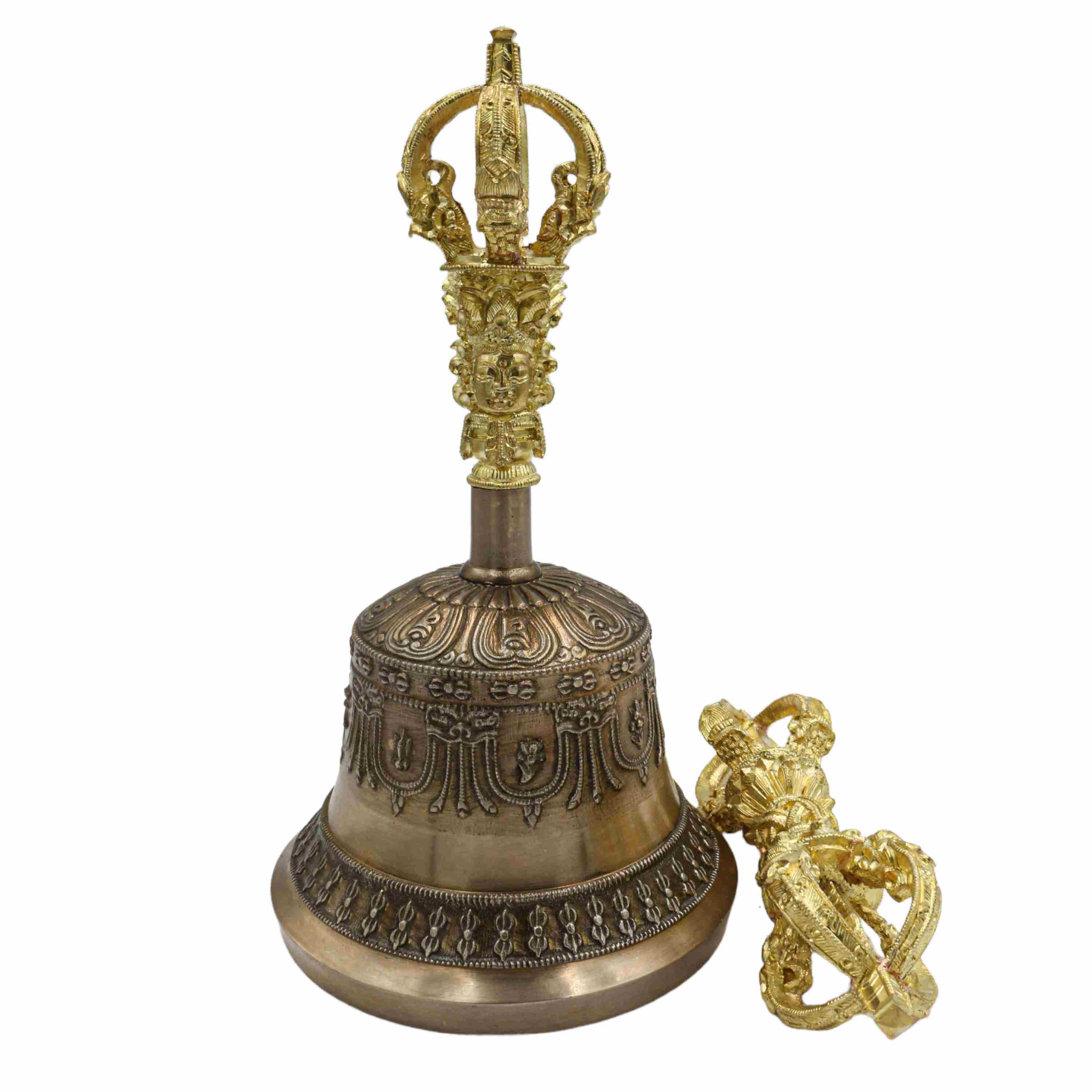Bell and Dorje
The dorje and bell are the primary Ritual Tools of Tibetan Buddhism. Always kept together they represent many layers of intricate symbolism and meaning and are used in almost all Tibetan ritual ceremony, chanting and magical operations. Primarily dorje and bell represent the masculine and feminine principles in the cosmos and in the individuals energy body. The dorje is always held in the right hand and the bell in the left as these are the sides of the right and left channels in the body.
Read More
Bell
As the archetypal feminine principle the Dill boo [bell] represents the perfection of wisdom which directly perceives the primordial nature of shunyata [emptiness]. Its sound describes emptiness as it the sound arises from silence and dissolves back into silence. As such it represents the mandala of creation and dissolution; the bottom rim of the bell reps the disc of emptiness from which all arises, these being symbolised by the ring of lower dorjes, the garlands of hanging pearls, the upper horizontal dorjes, all forming the base for eight seed syllables of the eight goddesses. The main feature fo the handle is the face of Vajra-para-mita, the greatest Goddess representing the union and perfection of all wisdom and awareness. From her elaborate crown rise the five wisdom jewels which form the vajra cap to the bell.
Dorje
DORJE
As the archetypal male principle the dorje it is the quintessential symbol of the 'diamond mind of enlightenment' so hard that it is able to cut through all illusions and deceits and arrive at the clearlight of truth in its two forms. These two forms of truth are symbolised by the two pronged dorje and are relative truth - needed for daily living ie. science, practical knowledge etc., and absolute truth which reveals the inner nature of the universe. The central hub from which the prongs arrive represents the sphere of actual reality. From this sphere arise two eight petalled lotuses crowned by two full moon 'discs' from which emerge the five upper and lower prongs. These five represent the Five Buddha families, the five elements, and the five skandhas [form- feeling - perception - motivation and consciousness- which the outer four are curved into and merge with at the tip.] As such the dorje is the great alchemical symbol and represents the creation of the 'philosophers stone'. In Tibetan dorje means the indestructible stone. The dorje is considered the ultimate spiritual weapon in that it is used to banish the forces of darkness, ignorance and disharmony with its power of lightning and clear truth. It is held in the right hand and twirled according to the pattern of the particular ritual, where it also represents 'skilful method'.
Dehradun : Dehradun Bell and Dorje
The bell and dorje crafted in Dehradun, India by Tibetan artisans are renowned for their exceptional quality sound and exquisite traditional designs. These bells and dorjes are meticulously handcrafted using age-old techniques passed down through generations, resulting in a product of outstanding craftsmanship.
The bell, also known as a "drilbu" in Tibetan, is made from high-quality metal alloys, typically bronze or brass. It features a distinctive shape with a wide base that gradually tapers toward the top. The bell's body is adorned with intricate patterns, intricate carvings, and traditional motifs that reflect the rich cultural heritage of Tibet. These designs are often inspired by Buddhist symbols, mantras, or deities, adding a spiritual dimension to the bell's aesthetics.
The Dorje, also called a "vajra" in Sanskrit, complements the bell perfectly. It is a ritual object shaped like a double-ended scepter and is traditionally made from a solid metal alloy. The Dorje symbolizes a thunderbolt or diamond, representing the indestructible and irresistible power of enlightenment. Like the bell, the Dorje is adorned with elaborate carvings and engravings, showcasing the skilled craftsmanship of the Tibetan artisans.
One of the standout features of these Dehradun-made bells and drones is their exceptional sound quality. The artisans pay meticulous attention to the bell's shape, weight, and thickness to ensure that it produces a resonant and melodious tone. When struck or rubbed along the rim with the Dorje, the bell emits a pure and harmonious sound that lingers in the air, creating a serene and meditative atmosphere.
The bell and dorje made in Dehradun are not only functional ritual objects but also cherished as pieces of art. They serve as symbols of spirituality, devotion, and mindfulness, making them sought-after items for practitioners of Tibetan Buddhism, collectors, and those who appreciate the beauty of traditional craftsmanship.
Whether used in religious ceremonies, meditation practices, or as ornamental pieces, these bells and dorjes from Dehradun, India, are highly regarded for their high-quality sound and best-quality traditional designs, embodying the rich cultural heritage of Tibet and the skilled craftsmanship of the artisans who create them.
Read More
